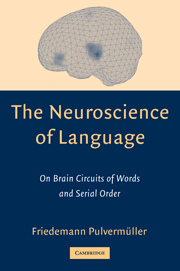Book contents
- Frontmatter
- Contents
- Preface
- The Neuroscience of Language
- 1 A Guide to the Book
- 2 Neuronal Structure and Function
- 3 From Classic Aphasia Research to Modern Neuroimaging
- 4 Words in the Brain
- Excursus E1 Explaining Neuropsychological Double Dissociations
- 5 Regulation, Overlap, and Web Tails
- 6 Neural Algorithms and Neural Networks
- 7 Basic Syntax
- 8 Synfire Chains as the Basis of Serial Order in the Brain
- 9 Sequence Detectors
- 10 Neuronal Grammar
- 11 Neuronal Grammar and Algorithms
- Excursus E2 Basic Bits of Neuronal Grammar
- Excursus E3 A Web Response to a Sentence
- 12 Refining Neuronal Grammar
- Excursus E4 Multiple Reverberation for Resolving Lexical Ambiguity
- Excursus E5 Multiple Reverberations and Multiple Center Embeddings
- 13 Neurophysiology of Syntax
- 14 Linguistics and the Brain
- References
- Abbreviations
- Author Index
- Subject Index
11 - Neuronal Grammar and Algorithms
Published online by Cambridge University Press: 15 December 2009
- Frontmatter
- Contents
- Preface
- The Neuroscience of Language
- 1 A Guide to the Book
- 2 Neuronal Structure and Function
- 3 From Classic Aphasia Research to Modern Neuroimaging
- 4 Words in the Brain
- Excursus E1 Explaining Neuropsychological Double Dissociations
- 5 Regulation, Overlap, and Web Tails
- 6 Neural Algorithms and Neural Networks
- 7 Basic Syntax
- 8 Synfire Chains as the Basis of Serial Order in the Brain
- 9 Sequence Detectors
- 10 Neuronal Grammar
- 11 Neuronal Grammar and Algorithms
- Excursus E2 Basic Bits of Neuronal Grammar
- Excursus E3 A Web Response to a Sentence
- 12 Refining Neuronal Grammar
- Excursus E4 Multiple Reverberation for Resolving Lexical Ambiguity
- Excursus E5 Multiple Reverberations and Multiple Center Embeddings
- 13 Neurophysiology of Syntax
- 14 Linguistics and the Brain
- References
- Abbreviations
- Author Index
- Subject Index
Summary
This chapter addresses the question of how to translate grammatical algorithms into the language of neuronal sets.
Regular Associations, Associative Rules
There has been some discussion about the question of whether the human mind and brain use neuronal principles and connections for processing grammatically related information, or whether it uses rules and algorithms specified by grammar theories (Elman, Bates, Johnson, Karmiloff-Smith, Parisi, & Plunkett, 1996; Pinker, 1994). This proposal suggests that these positions, which are sometimes considered to exclude each other, are, in fact, both correct. This is not meant in the sense that there are two modules or systems, one for neural networks and the other one for rule algorithms (Pinker, 1997), but in the sense that rules are abstract descriptions of the neuronal machinery, as they are, without any doubt, descriptions of aspects of human behavior and action (Baker & Hacker, 1984).
If rules and algorithms are adequate descriptions of aspects of human behavior and action, they must have a basis in neuronal structure and function. As stressed in the discussion of the McCulloch–Pitts theory (Section 6.1), a neuronal network can be reformulated using calculus or by a logical formula. It is therefore reasonable to ask which putative neurobiological counterparts exist for syntactic rules and, conversely, how a neuron circuit sensitive to serial order can be adequately described algorithmically.
The cortex is an associative memory and would therefore be difficult to imagine it ignoring the correlation of words and morphemes in its input.
- Type
- Chapter
- Information
- The Neuroscience of LanguageOn Brain Circuits of Words and Serial Order, pp. 207 - 214Publisher: Cambridge University PressPrint publication year: 2003



